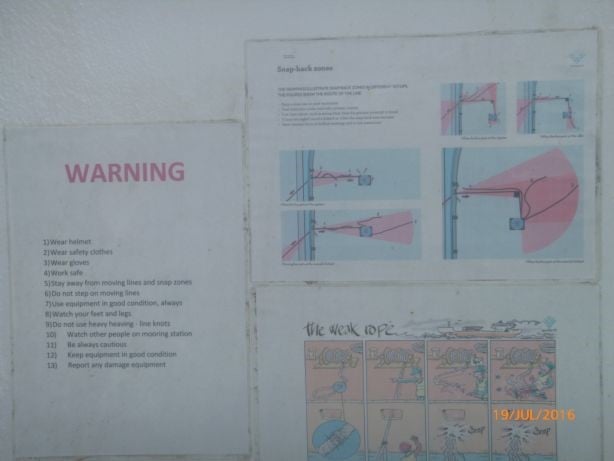Mooring lines are clearly an essential part of the ship's rigging and are used each time the vessel is arriving at and departing from a port, receiving tug assistance, towing another vessel or in STS operations.
Claims arising from the above mentioned operations are frequently received by the Club and the most dramatic consequences are loss of life or total disability.
Parting mooring lines may happen due to different factors, including but not limited to excessive wear and tear, excessive forces created by the vessel moving, wind, current, mooring winches or a combination of same.
Most of the incidents could be avoided if seafarers and shore personnel (mooring men) would follow best mooring practice and use personal protective equipment.
In order to alert seafarers of the potential danger of a parting line the fore and aft mooring decks of many vessels are marked with snap zones. Code of Safe Working Practices of Merchant Seafarers, article 26.3, recommends to avoid painting of snap-back zones as it may give a false sense of security as the entire mooring area should be considered as a potential snap-back zone.
The best practice is to place posters with snap-back zones on mooring stations as indicated below.

In addition, a warning "DANGER! ENTERING SNAP-BACK ZONE" is recommended to be placed before entering aft and fore mooring stations.
Sometimes shore personnel become a victim of a parting mooring line. In such case the vessel will be held liable for all consequences arising thereof such as disability compensation or compensation to the family of the deceased. Sums at stake could be astronomical in some jurisdictions.
In a recent case the aft first spring broke and hit two shore mooring men who were standing beside the bollard. In the incident one mooring man passed away and another was rushed to the hospital immediately. Verbal demand of USD 5 million for bank guarantee from the harbour master. Luckily the police and coroner decided not to prosecute the master and deemed the incident an accident as the pilot was in control of the vessel at the time of berthing and the demand for security has been reduced to USD 1 million.

In order to ensure safety of mooring operations we recommend the following:
- Pre-operational check. Mooring winches are to be tested prior mooring operations to make sure that all is functioning well without deficiencies. Mooring lines have to be visually inspected on a regular basis and in case of extensive wear and tear to be replaced with new ones.
- Person in charge. Sufficient experience is required to conduct mooring operations in a safe fashion. That is why a person in charge, usually an officer or bosun is to be stationed/be in command on aft and fore mooring stations.
- The use of PPE (Personal Protective Equipment). It is of significant importance that all required PPE is used. A responsible person has to make sure that all seafarers wear boiler suits, safety helmets, shoes, gloves and glasses.
- Risk assessment. All personnel involved in the mooring operation are to go through the risk assessment of the operation. This assessment is to be completed prior operation and to highlight all possible risks connected to the operation and what to be done to reduce those risks to a minimum level.
- Pre-work talk. The person in charge of mooring operations should obtain instructions from the master and communicate same to the crew members prior to commencement of mooring operation. This can be just a couple of minutes' discussion about mooring plan and what to be aware of when the operation starts. The discussion should include awareness of where to put your feet, awareness of a clean working space, to avoid slippery decks and snap back zones.
- Communication. Suitable and good quality communication should be established between the bridge and the responsible persons at mooring stations, usually via portable radio. As a safety precaution a second portable radio should be available for immediate use on a mooring deck. Observed dangers including other vessels, tugs etc. which can lead to ship movement should be communicated in good time.
- Shore mooring gangs. When possible the crew should communicate its intention with shore personnel in clear language and well in advance.